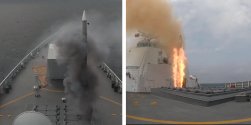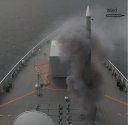Google translate:
“On a Type 052D destroyer, the 8 silos near the superstructure are for hot launch anti-ship missiles, the ones in front for cold launch anti-aircraft missiles for example. The VLS is of CCL type which supports two different types of launch.”
Any idea why the PLAN would make the choice of hot launch being closer to the superstructure?
In addition to what Tam mentioned above, this arrangement (cold launchers further away from the superstructure than hot launchers) may be related to the possibility that an HHQ-9 missile fails to ignite in the air. In that case, it is better to fall into the water than on the deck (or at least as far away from the superstructure as possible). In the picture, the HHQ-9 launcher is placed closer to the ship's side and its narrower bow. The 052D destroyer just needs to make a slight left turn while launching the missile for the potential "dud" to fall across the starboard bulwark. This would be much more difficult if the HHQ-9 missile was launched from the position where the YJ-18 missile was launched (also considering the position's smaller turning radius away from the stern).

Last edited:



